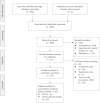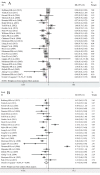Effect of statin therapy on mortality from infection and sepsis: a meta-analysis of randomized and observational studies
- PMID: 24725598
- PMCID: PMC4056771
- DOI: 10.1186/cc13828
Effect of statin therapy on mortality from infection and sepsis: a meta-analysis of randomized and observational studies
Abstract
Introduction: Observational data have suggested that statin therapy may reduce mortality in patients with infection and sepsis; however, results from randomized studies are contradictory and do not support the use of statins in this context. Here, we performed a meta-analysis to investigate the effects of statin therapy on mortality from infection and sepsis.
Methods: We searched electronic databases (PubMed and Embase) for articles published before November 2013. Randomized or observational studies reporting the effects of statin therapy on mortality in patients with infection or sepsis were eligible. Randomized and observational studies were separately pooled with relative risks (RRs) and random-effects models.
Results: We examined 5 randomized controlled trials with 867 patients and 27 observational studies with 337,648 patients. Among the randomized controlled trials, statins did not significantly decrease in-hospital mortality (RR, 0.98; 95% confidence interval (CI), 0.73 to 1.33) or 28-day mortality (RR, 0.93; 95% CI, 0.46 to 1.89). However, observational studies indicated that statins were associated with a significant decrease in mortality with adjusted data (RR, 0.65; 95% CI, 0.57 to 0.75) or unadjusted data (RR, 0.74; 95% CI, 0.59 to 0.94).
Conclusions: Limited evidence suggests that statins may not be associated with a significant reduction in mortality from infection and sepsis. Although meta-analysis from observational studies showed that the use of statins was associated with a survival advantage, these outcomes were limited by high heterogeneity and possible bias in the data. Therefore, we should be cautious about the use of statins in infection and sepsis.
Figures




References
-
- Levy MM, Fink MP, Marshall JC, Abraham E, Angus D, Cook D, Cohen J, Opal SM, Vincent JL, Ramsay G. SCCM/ESICM/ACCP/ATS/SIS International Sepsis Definitions Conference. Crit Care Med. 2003;2001:1250–1256. - PubMed
-
- Lever A, Mackenzie I. Sepsis: definition, epidemiology, and diagnosis. BMJ. 2007;335:879–883. doi: 10.1136/bmj.39346.495880.AE. - DOI - PMC - PubMed
Publication types
MeSH terms
Substances
LinkOut - more resources
Full Text Sources
Other Literature Sources
Medical

